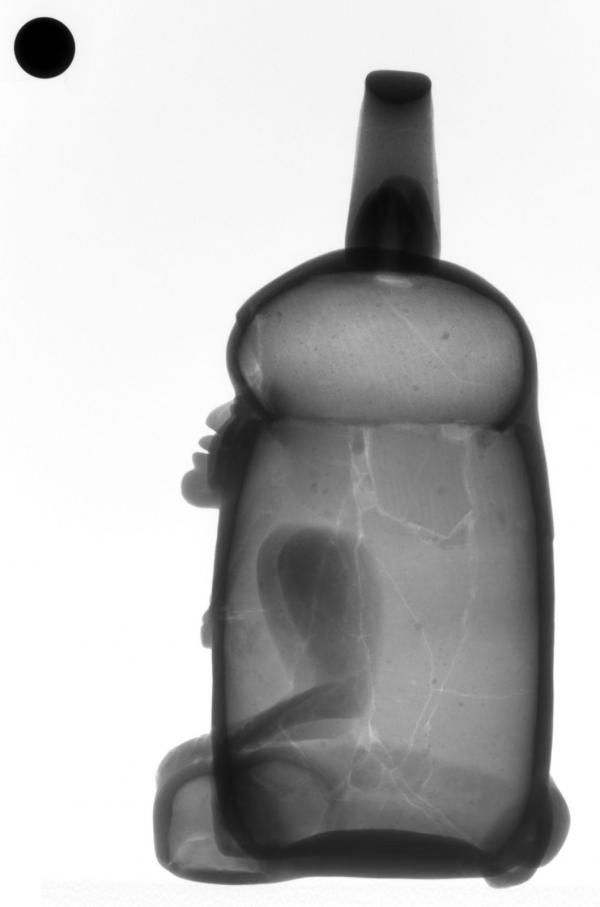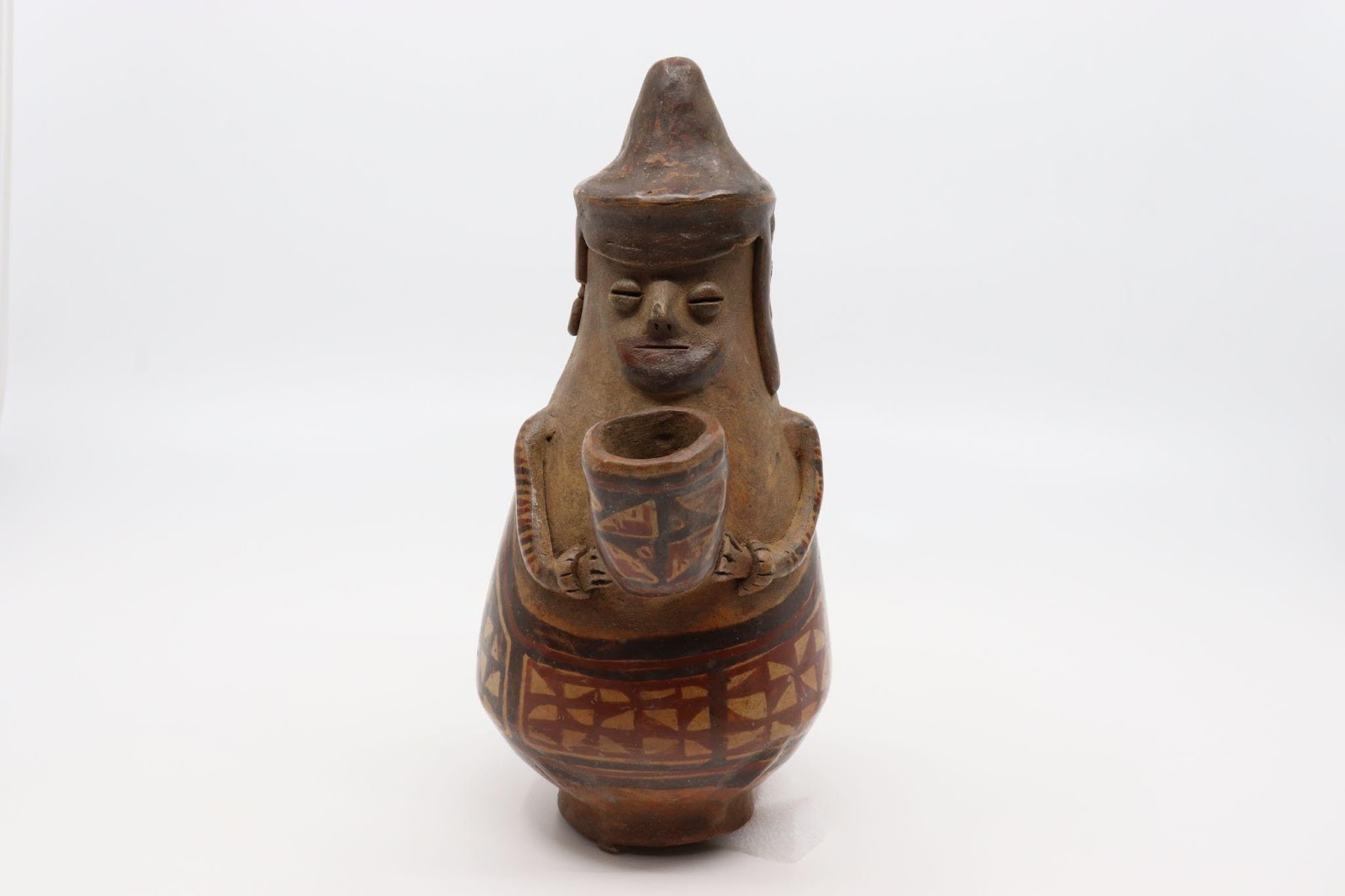During the fall semester of 2021 at California State University, Dominguez Hills, I had the privilege of working at LACMA's off-site facility through the CSUDH-LACMA Visiting Scholars Program, which focused on the museum's Art of the Ancient Americas collection. One of the topics covered in this program was identifying forgeries. A forgery is a copy or replica that is passed off as being authentic. In the Art of the Ancient Americas collection, a forgery would be an artifact that is marketed as “ancient” or belonging to an Indigenous group, when in fact it is modern or made by another group. Sometimes forged items end up in museum collections, and further research may determine that an object has characteristics that indicate it is a forgery or a replica. Determining if something is forged requires a lot of resources and involves different methods; it is an important responsibility of museum curators. This caught my attention because it never crossed my mind how common it was for museums to have forgeries in their collections.
One of the reasons that museums end up with forgeries is that reliable information about ancient civilizations can be scarce. There has also been a great deal of illegal excavations and looting, leaving us with no background information as to how, where, and when some artifacts were found. Artifacts were also, and still are, sold on the private market. As interest in owning antiquities and artifacts increases, their value increases, which leads to people make forgeries to sell. Many private collectors have an intermediary, making these transactions in secret, which means they may not notice that they are not authentic. Curators always do thorough research before accepting items, but high-quality forgeries may still end up in museums that do not have the time or resources to verify the authenticity of all the items until after the donation is accepted. It can take many years for items to be carefully and efficiently analyzed.
Some pieces may be obviously forged by creators with a lack of knowledge about the society of origin, but some forgers can be very skillful. There are often disagreements about the authenticity of an item even among experts. The object pictured below is from the Nariño culture from the mountains of Nariño, Colombia, but has unexpected characteristics for this region, and an imitation of resist painting that typically involves adding a form of glaze or wax to create a pattern on the object and to protect it from the later stages of the art-making process. If authentic, its date ranges from 800–1500 AD. Julia Burtenshaw, Associate Curator of the Art of Ancient Americas at LACMA, analyzed factors like material, size, shape, iconography, form, condition, and signs of age to determine the authenticity of this piece. Not only was the painting technique unusual, but the form and style of this vessel were unusual as well. The coffee bean–shaped eyes, hat, and beaker this figure is holding are typical of the ancient Andes, but they are never represented this way, especially not in the region of Colombia where this item was supposed to originate. In terms of the age of this vessel, it lacks signs of wear and old age. All these factors are what determine the piece to be a forgery.
There are other more scientific ways that researchers can evaluate authenticity. If, for example, the item is made of organic components, like bones, wood, or charcoal, they can use radiocarbon dating, which can help identify an approximate date of creation. To perform radiocarbon dating, they must take a sample from an object. Once organic material has died, the Carbon-14 (C-14) in it is no longer affected by the biosphere and it starts to decay. This process is called beta decay, where an atom of C-14 decays into an atom of Nitrogen-14. During this process, one of the neutrons in the carbon atom becomes a proton, increasing the number of protons in the atom by one. This decay takes thousands of years and the amount of protons found in a sample can tell archaeologists the amount of time that has passed since this organic material died. The amount of time it takes for half of the original amount of C-14 to decay is called its half-life, and C-14 has a half-life of 5,730 years. After that amount of time, only half of the initial amount of C-14 is left in a sample, and researchers can calibrate these dates and then reference them to historical dates. After 10 half-lives, though, it is difficult to detect C-14. For example, fossil fuels, which are older than 50,000 years, have no C-14 remaining.
Another way to date an item is by using thermoluminescence dating. This method can be used on non-organic materials such as ceramic, stone, and metal, which absorb and hold onto electrons, trapping them in defects in the molecular crystal structure when alpha, beta, and gamma radiation goes through them. When you heat these items, they release these trapped electrons, and the energy is then emitted in the form of light. For instance, when you fire ceramics, it erases the previous geological thermoluminescence that then causes the thermoluminescence to grow over time. The natural radioactivity within the environment of the object determines the rate of the thermoluminescence growth as well as the content of the object. The age of the object is assessed by taking a sample and measuring the total dose absorbed since its last heating, the measure of its thermoluminescence, and the rate that the material would have absorbed the radiation in that environment.
One particularly tricky issue is when an authentic object has modern parts added to it. That is what happened to an object that we examined in the Visiting Scholars program, a female figure jar that had an x-ray taken of it previously, and was determined to have some pieces added later on. This particular double-spouted jar was produced in the style of the Calima Ilama culture of ancient Colombia (c. 1000 BCE–100 CE).
X-radiography is a non-invasive technique that curators and archaeologists use to examine artifacts. It can be affordable, and the images can be archived making it useful for future use. X-radiography is used to determine the material composition and crystalline structure of artifacts. This method can help researchers tell the original parts of an object from later additions and restoration. It also is a good tool for viewing an object that is not easily identifiable, and reveals surface details such as decoration and lettering. It’s a non-invasive technique that does not harm artifacts, since researchers can use x-rays to observe both surface details and internal anomalies without having to open or damage an artifact. There are ways to determine damage and anomalies externally without using x-radiography, like inconsistencies in crazing, glaze texture, color, cracks, and chips, but to get a clearer picture of how extensive damage or anomalies are, x-radiography is the perfect tool to use. In the image above, the x-ray reveals the internal structure of the jar, providing a clear view of the extensiveness of the repairs and additions that were done later on. You can see the fractures along the body and head of the figure, and tell that the head isn’t flush with the body because of the dark shadow between the head and body.
Simply spending time with an object can also prove to be a good method to determine its authenticity. Before researchers can use the methods mentioned above, they first must analyze the object to determine if testing is needed, because these testing methods take time and money, and can damage the object when a sample is taken. It would be unfortunate for a sample to be taken from an object when there are less damaging ways to test its authenticity, like analyzing its paints, burnishing marks, materials, design, or form. Sometimes other experts are also contacted to help with this process if they have more experience with the society from which the object came.
Working as a Visiting Scholar at LACMA has taught me a lot about curating and how items are brought into museums. Working with forged and restored items opened my eyes to how difficult it is to test the authenticity of an artifact. A lot of researchers, experts, and technology are involved and it can take many years for curators to go through the objects in a museum’s collection. Thanks to CSUDH and LACMA, I’ve been able to work with museum experts and learn about the hard work that is put into caring for these objects.




